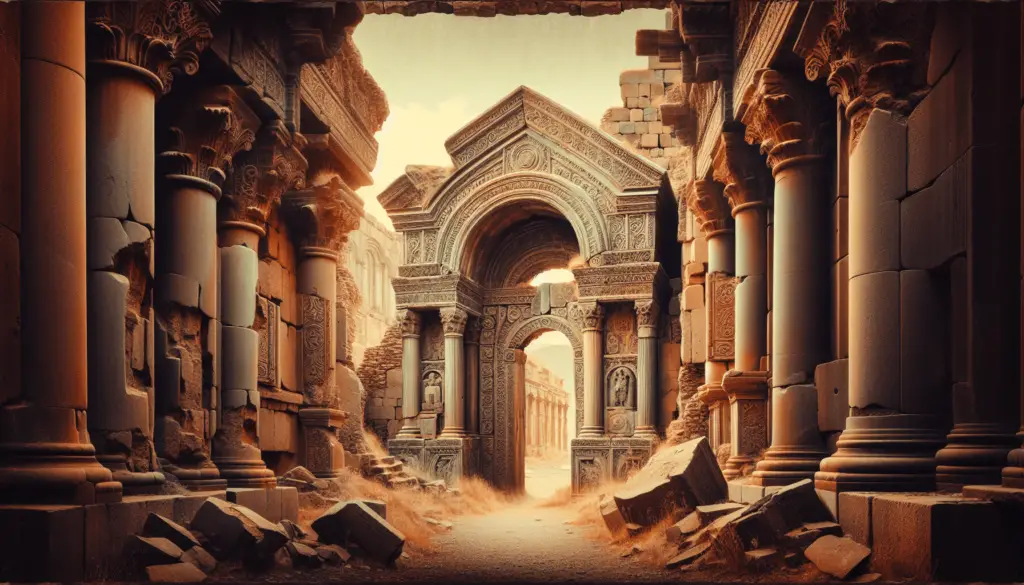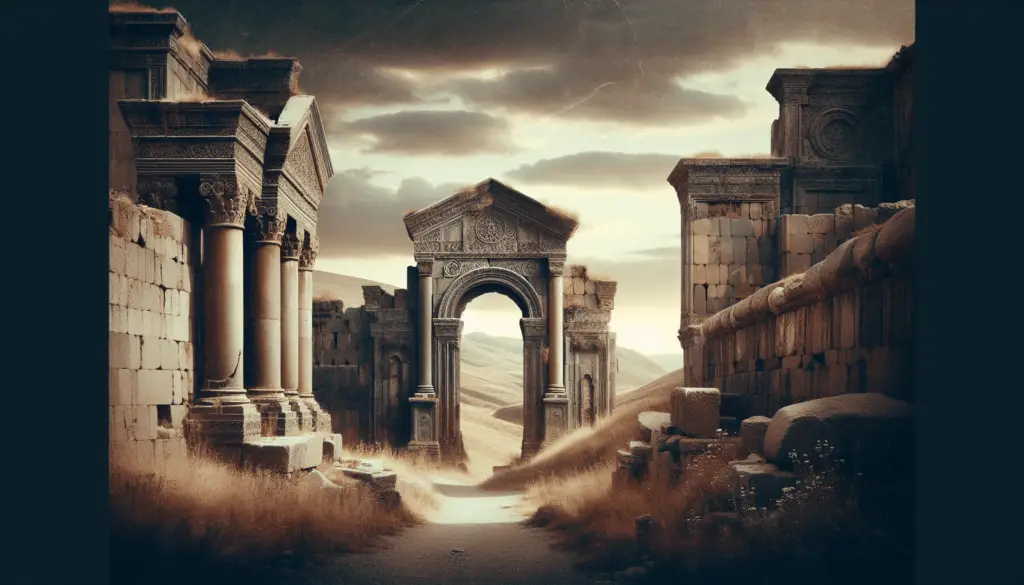Imagine stepping back in time and exploring the enchanting wonders of a forgotten Armenian capital. Nestled along the Turkish-Armenian border, the ancient city of Ani beckons with its rich history and breathtaking architecture. Embark on a journey that unravels the mysteries of this once-thriving metropolis, as you wander through its stunning ruins and marvel at the remnants of a bygone era. With every step, immerse yourself in the grandeur of Ani’s past and uncover the secrets that lie within its ancient walls. Get ready to be transported to a time long ago, as we take you on a captivating exploration of the fascinating Ancient City of Ani.

Introduction to the Ancient City of Ani
Welcome to the ancient city of Ani, a remarkable treasure nestled within the borderlands of modern-day Turkey and Armenia. With a rich history that dates back over a millennium, Ani holds a significant place in the annals of civilization. Its stunning architectural marvels, diverse cultural influences, and religious heritage make it a captivating destination that has captivated historians, archaeologists, and travelers alike.
Historical Significance of Ani
Ani’s historical significance stretches far and wide, tracing its roots back to the 5th century AD. As the capital of the medieval Bagratid Kingdom of Armenia, Ani played a crucial role in shaping the region’s political, cultural, and religious landscape. It served as a vital hub for trade along the Silk Road and became a melting pot of different cultures and religions, including Armenian, Byzantine, and Islamic influences.
Location and Geography
Situated on a rocky plateau overlooking the Akhurian River, Ani boasts a strategic location that provided natural defenses against potential invaders. The city’s proximity to trade routes facilitated its growth and prosperity, making it an important center of commerce and cultural exchange between the East and the West. The surrounding landscape, with its picturesque valleys and majestic mountains, adds to the allure of this once-thriving metropolis.
Overview of Ani’s Architecture and Culture
Ani is renowned for its breathtaking architecture, which showcases the ingenuity and creativity of its builders. The city boasts a splendid collection of churches, cathedrals, walls, palaces, and citadels that reflect various architectural styles and influences. From the ornate stonework of the Church of St. Gregory to the grandeur of the Cathedral of Ani, each structure tells a story of the city’s rich past. The vibrant culture of Ani is evident in its artistic traditions, including intricately carved stone reliefs and frescoes that adorn its buildings.
History of Ani
Origins of Ani
Ani’s origins can be traced back to the 5th century AD when it was established as a small settlement on the Armenian highlands. Over time, it grew in importance and became the capital of the Bagratid Kingdom of Armenia in the 10th century AD. The city’s strategic location along major trade routes contributed to its rapid growth and prosperity, attracting merchants, artisans, and scholars from far and wide.
Development and Growth
During the 10th and 11th centuries, Ani experienced a period of unprecedented growth and development. The city flourished under the rule of the Bagratid dynasty, with the construction of grand palaces, citadels, and churches that showcased the wealth and power of the kingdom. Ani’s population swelled to over 100,000 inhabitants, making it one of the largest and most prosperous cities of its time.
Golden Age of Ani
Dubbed the “City of 1001 Churches,” Ani reached its zenith during the 11th and 12th centuries, becoming a hub of religious and cultural life in the region. The city’s churches, with their intricate stone carvings and stunning architectural details, became symbols of Armenian Christianity’s strength and resilience. Ani’s golden age was marked by a flourishing economy, vibrant trade, and a thriving artistic and intellectual community.
Decline and Abandonment
Sadly, Ani’s glorious days came to an end in the 13th century when the city fell victim to a series of invasions, earthquakes, and political instability. The Mongol invasion of 1236 dealt a devastating blow to Ani, leading to its gradual decline and abandonment. The city was left in ruins, its once grand structures reduced to remnants of a bygone era.
Rediscovery and Excavations
Early Rediscovery of Ani
After centuries of obscurity, Ani began to attract the attention of explorers, archaeologists, and writers in the 19th century. European travelers, captivated by the tales of a lost medieval city, ventured to the region to seek out the fabled city of Ani. They documented their discoveries and shared their findings, reigniting interest in this forgotten Armenian capital.
Efforts to Uncover the Ancient City
In the 20th century, more systematic excavations and restoration efforts were undertaken to uncover Ani’s hidden treasures. Archaeologists meticulously unearthed the remains of churches, palaces, and other structures, piecing together the puzzle of Ani’s past. The delicate process of restoration aimed to revive the grandeur of this once-great city, allowing visitors to glimpse its former glory.
Archaeological Findings
The archaeological findings at Ani have shed light on the city’s illustrious past and deepened our understanding of medieval Armenian architecture and culture. Intricate carvings, religious artifacts, and remnants of daily life have been unearthed, showcasing the craftsmanship and artistic prowess of the city’s inhabitants. These discoveries continue to be invaluable in piecing together the story of Ani’s rise and fall.

Ani as a UNESCO World Heritage Site
Inclusion in the World Heritage List
In recognition of its outstanding universal value, Ani was inscribed on the UNESCO World Heritage List in 2016. This prestigious nomination highlights the significance of Ani as a cultural and historical site of global importance. It brings international recognition and increased attention to the need for its preservation and conservation.
Criteria for Selection
Ani’s inclusion in the World Heritage List was based on several criteria. Firstly, it showcases a significant interchange of human values, as witnessed by its distinctive architectural styles and diverse cultural influences. Secondly, Ani bears an exceptional testimony to a cultural tradition or civilization that is no longer living. Lastly, it is an outstanding example of human settlement or land-use that represents significant periods of history.
Preservation and Conservation Efforts
With its newfound status as a UNESCO World Heritage Site, Ani enjoys heightened protection and conservation measures. Local and international organizations are actively involved in preserving the city’s architectural wonders and raising awareness about its historical and cultural value. Restoration projects, ongoing archaeological research, and tourism management strategies all contribute to safeguarding Ani for future generations.
Architectural Marvels of Ani
Churches and Cathedrals
Ani’s most impressive architectural achievements can be witnessed in its churches and cathedrals. The Cathedral of Ani, with its imposing Byzantine-influenced design, stands as a testament to the city’s former grandeur. The Church of St. Gregory, adorned with intricate carvings and fine masonry, showcases the exceptional craftsmanship of Ani’s builders. Other notable churches include the Church of St. Gregory of Tigran Honents and the Church of St. Prkich, each with its unique architectural features.
The Walls of Ani
Ani’s protective walls were a formidable defense system, encircling the city and creating a sense of security for its inhabitants. The walls, constructed with immense precision and engineering skill, served as a visual representation of Ani’s power and authority. Sections of these walls still stand today, offering visitors a glimpse into the city’s past and breathtaking views of the surrounding landscape.
Palaces and Citadels
The palaces and citadels of Ani reflect the opulence and sophistication of its ruling elite. The Palace of the Armenian Bishops, with its grand halls and intricate decorations, served as the administrative and spiritual center of the city. The Citadel of Ani, perched on a hilltop, provided a strategic vantage point and housed the residence of the Bagratid kings. These structures offer insights into the luxurious lifestyle and cultural patronage of Ani’s rulers.
Urban Layout and Infrastructure
Ani’s urban layout was characterized by a well-planned network of streets, squares, and markets. The city boasted an impressive array of public buildings, including baths, caravanserais, and shops, testifying to its thriving commercial and social life. The meticulous design and organization of Ani’s infrastructure demonstrate the city’s advanced architectural and engineering knowledge for its time.
Cultural and Religious Significance
Armenian Christian Heritage
Ani holds immense religious significance for Armenians as a symbol of their Christian heritage. The city was an important center for Armenian Christianity, with numerous churches and monasteries dotting its landscape. These religious institutions served as places of worship, centers of learning, and sanctuaries for the faithful, fostering spiritual growth and cultural preservation.
Multicultural Influences
Ani’s location at the crossroads of various civilizations and trade routes resulted in a multicultural environment that influenced its architecture, language, and traditions. Byzantine, Seljuk, and Islamic influences can be seen in Ani’s diverse architectural styles and artistic flourishes. This fusion of cultures and ideas contributed to Ani’s cosmopolitan character and enriched its cultural heritage.
Art and Craftsmanship in Ani
Ani was a thriving center for artistic expression, with skilled craftsmen producing exquisite carvings, frescoes, and other forms of artistic works. The city’s churches and palaces are adorned with intricate stone reliefs, depicting biblical scenes, animals, and geometric patterns. These masterpieces not only reflect the artistic prowess of Ani’s artisans but also serve as valuable historical and cultural artifacts.
Visiting Ani: Practical Information
Accessibility and Transportation
Visiting Ani requires some planning due to its remote location. The nearest major airport is Kars Harakani Airport in Turkey, from where you can hire a private car or join a guided tour to reach Ani. The journey from Kars to Ani takes approximately one to two hours. It’s important to check visa requirements and border crossing formalities when traveling between Turkey and Armenia.
Entry Fees and Permits
There is an entry fee to visit Ani, which contributes to the maintenance and preservation efforts of the site. It is advisable to check the latest fee information and any permit requirements before your visit. Guided tours are available at an additional cost and are highly recommended to make the most of your visit and gain deeper insights into the history and significance of Ani.
Guided Tours and Visitor Services
To enhance your experience at Ani, guided tours are available and are highly recommended. Local guides provide expert knowledge and insights into the complex history and architectural wonders of Ani. They can tailor the tour to suit your interests and ensure you don’t miss any hidden gems. Visitor services such as information centers, restrooms, and souvenir shops are also available for convenience.
Accommodation Options Nearby
While Ani itself does not offer accommodation options, there are several hotels and guesthouses available in nearby cities such as Kars and Gyumri. These cities provide convenient bases for exploring Ani and offer a range of accommodations to suit different preferences and budgets. It is advisable to book in advance, particularly during peak travel seasons, to secure your preferred accommodation.
Preserving Ani’s Legacy
Challenges to Preservation
Preserving Ani’s legacy presents a multitude of challenges due to its remote location, fragile structures, and limited resources. Natural elements such as erosion and seismic activity pose threats to the architectural wonders of Ani. Additionally, illegal excavations, looting, and neglect have further endangered the preservation of this historical site.
Local and International Initiatives
To address these challenges, local and international organizations have joined forces to protect and preserve Ani. Collaborative efforts have been undertaken to combat illegal activities, raise awareness about its importance, and provide technical expertise in restoration and conservation. These initiatives emphasize the shared responsibility of all stakeholders in safeguarding Ani for future generations.
Importance of Raising Awareness
Raising awareness about Ani’s cultural and historical significance is crucial to its preservation. Education programs, public outreach campaigns, and cultural events all play a role in fostering appreciation for Ani’s heritage among locals and international visitors alike. By promoting responsible tourism and encouraging sustainable practices, we can ensure that Ani remains a place of inspiration and reverence for generations to come.
Ani in Literature and Art
Depictions in Historical Texts and Poems
Throughout history, Ani has captivated the imagination of writers, poets, and historians, who have immortalized its splendor in their works. Historical texts and poems often describe Ani as a majestic city adorned with palaces, churches, and bustling marketplaces. These literary accounts offer glimpses into the grandeur and cultural significance of Ani during its heyday and attest to its enduring legacy.
Influence on Armenian Literature
Ani’s profound impact on Armenian literature cannot be overstated. Numerous poems, novels, and songs have been dedicated to capturing the essence of the city and celebrating its architectural wonders. Writers have drawn inspiration from Ani’s rich history and cultural heritage, infusing their works with themes of longing, resilience, and national identity.
Artistic Representations of Ani
Artists, too, have been fascinated by Ani’s enchanting beauty, inspiring them to create stunning portrayals of the city. Paintings, sculptures, and photographs have immortalized Ani’s architectural marvels and picturesque landscapes, allowing viewers to experience its magnificence through the eyes of the artist. These artistic representations serve as testaments to Ani’s enduring allure and evoke a sense of nostalgia for this lost Armenian capital.
The Future of Ani
Prospects for Restoration and Conservation
The future of Ani holds great promise as ongoing restoration and conservation efforts continue to breathe life into its ancient ruins. With concerted efforts from local and international stakeholders, the preservation of Ani’s architectural treasures remains a top priority. New technologies, research, and innovative approaches offer hope for the restoration of Ani’s grandeur and for future generations to experience its magnificence.
Tourism and Economic Development
The growing interest in Ani as a tourist destination has the potential to boost economic development in the surrounding areas. Responsible and sustainable tourism can contribute to the preservation of Ani while providing economic opportunities for local communities. By creating infrastructure, training local guides, and promoting cultural exchange, tourism can play a vital role in supporting the long-term sustainability of Ani.
Importance of Safeguarding Ani for Future Generations
Safeguarding Ani is not just a historical imperative; it is a responsibility we owe to future generations. The preservation of its ancient ruins, cultural heritage, and architectural marvels ensures that Ani’s rich legacy lives on, inspiring and educating generations to come. By embracing Ani’s historical significance and taking active measures to protect it, we can ensure its enduring presence in the world and the lessons it can teach us about the past, present, and future.

